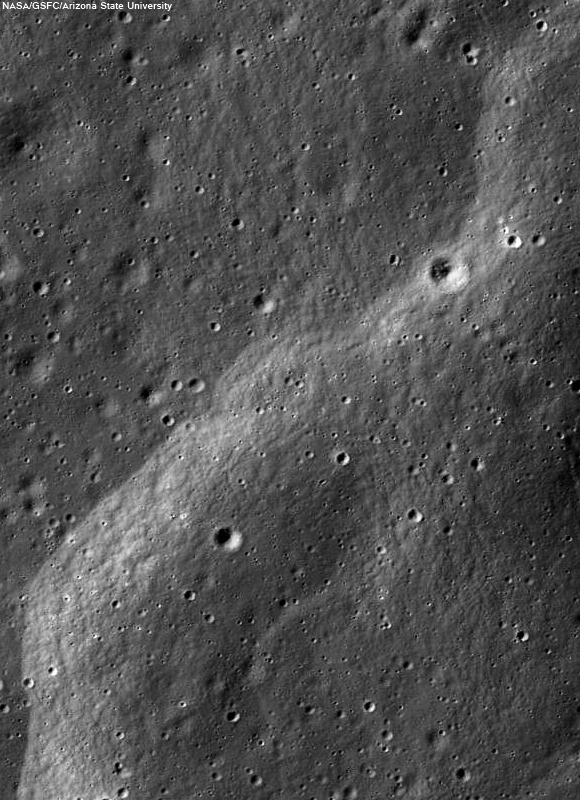 |
| An impact melt veneer coating a large boulder, roughly 80 meters by 120 meters in size, larger than a football field! Downslope to the right, LROC Narrow Angle Camera (NAC) observation M169630027R, orbit 10132, September 2, 2011; image field of view is 530 meters across, inclination 47.19° at 0.56 meters resolution from 54.5 kilometers overhead. View the larger LROC Featured Image HERE [NASA/GSFC/Arizona State University]. |
LROC News System
Ryder crater (43.877°S, 143.246°E, ~15 km diameter) is a Copernican-aged crater located within the South-Pole Aitken basin. A pond of impact melt is present on the crater floor, and boulders and melt streamers pepper the crater rim. Taking a look at the crater wall just interior to the rim (opening image), the wall is littered with boulders of varying sizes and shapes as well as areas smoothed by impact melt flows and veneers. Even though substantial ejecta and impact melt were deposited exterior to the crater, the rim and immediate surroundings were also littered with vast quantities of ejected material and impact melt. Today's Featured Image displays the complicated relationship between impact melt and ejecta emplacement, specifically around the crater rim.
 |
| Interspersed with melt-covered boulders are sections of impact melt channels (43.878°S, 143.021°E). Erosion over time has fractured and fragmented the channels and not many areas like the one pictured above are visible in this image. Downslope to the right, NAC M1696330027R, field of view 530 meters; view the full sized image HERE [NASA/GSFC/Arizona State University]. |
In some places, the crater wall is very smooth, indicating that the impact melt deposited was thick enough to bury the fractured wall material. However, as observed in the opening and above images, jumbles of boulders and fragmented ejecta are interspersed among impact melt-smoothed surfaces. Many of these boulders are veneered with impact melt where a thin layer of impact melt splashed onto the surface of the rock and solidified, and some boulders are partially buried within the smoother regions of impact melt. Some boulders do not appear to have impact melt veneers at all - why might that be? Furthermore, channels formed in some places that allowed impact melt to flow from the crater rim back toward the crater floor.
 | |
| HDTV still looking north over Ryder crater from Japan's lunar orbiter Kaguya (SELENE-1, 2009). By way of Charles Wood's Lunar Picture of the Day (LPOD), December 26, 2009 [JAXA/NHK/SELENE]. |
Unlike other channels, those observed in the above image are not as well-formed, suggesting that less melt utilized these pathways and perhaps the impact melt had cooled substantially as it flowed back into the crater so that it was not able to flow quickly nor hot enough to maintain thermal erosion in the channels. However, as seen in the above image, the channel halts abruptly in the downslope direction (right side of the image). What could be the cause?
 |
| LROC WAC monochrome mosaic of Ryder crater. Note the massive slump originating from the eastern wall and the pond of impact melt on the crater floor. Asterisk notes location of opening image (43.895°S, 142.988°E). View the LROC context image HERE [NASA/GSFC/Arizona State University]. |
The answer to both the halted channel and presence of boulders without melt veneer is that erosion has taken place since Ryder crater formed. Simply put, things (rocks) like to move downhill. Over time, boulders from the crater rim and higher up on the crater walls dislodged and traveled toward the crater center. While some of these blocks do not have impact melt veneers now, they may have in the past, but their downhill travels may have fractured those blocks even further so that any melt veneer present cracked off or was left behind on another fragment. Take a look at the central boulder in the opening image; although the majority of the boulder face visible has an impact melt veneer, there are fractured areas of the block that do not. Additionally, crater wall erosion may be invoked as an explanation for the apparent halt in the impact melt channel. Observations of the cracks perpendicular to the channel flow direction suggest that the jagged edge of the channel (middle-right) probably cracked off and fragmented to fall toward the crater floor. Or perhaps the ejecta blocks entrained within the melt that formed the channel dislodged and carried the lower portion of the channel downhill.
How many different impact melt features and morphologies do you observe when you traverse the entire LROC NAC frame, HERE? In case you missed it, and be sure to check out the LROC NAC oblique view of Ryder crater, released this past week, HERE.
Related Posts:
Farside impact!
On the Floor of Thales
Lichtenberg B Flow
Impact melt channel


































